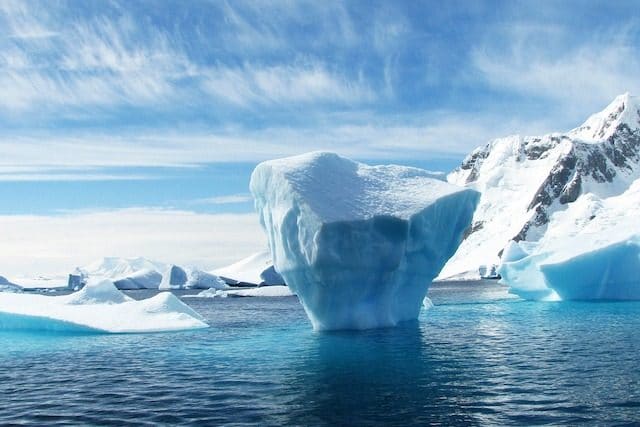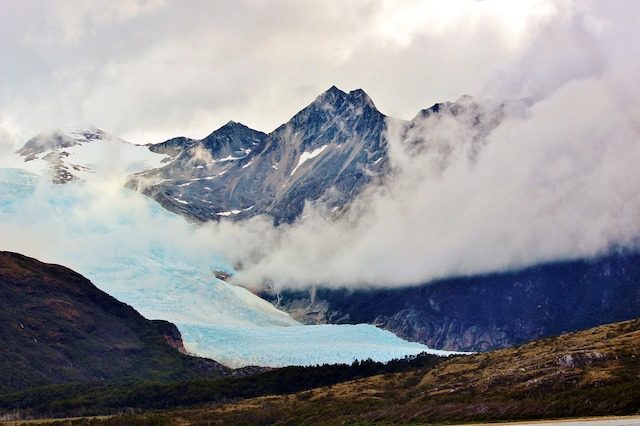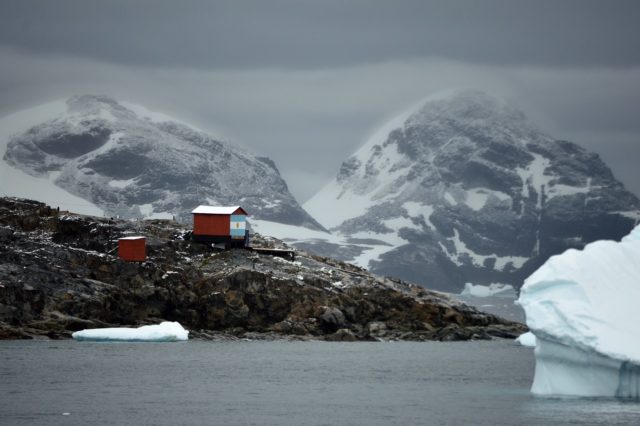In 1968, Ohio State University glaciologist John Mercer wrote a paper about the dangers of the Antarctic ice cap melting. He studied data from glaciers and dry lakes that had evidence of once being submerged and concluded that there must have been a time when all that ice was liquid, about 120,000 years ago. He then posited that this could happen again. That the ice could melt and sea levels could drastically rise.
The idea of holes in the ozone layer, and then global warming, and then climate change causing ice caps to melt is clearly not new. It’s been around for a long time, but it never really picked up steam until the 1970s. That was when satellites were first used to measure the ice, and the loss could be definitively shown. In the 1990s, the melting of the ice sheet covering Greenland dramatically increased, doubling the rate it had been experiencing since the 1960s.
By 2021 and 2022, the amount of ice loss had escalated significantly. Both years had ice losses of above the average of the entire previous decade. Seven of the ten most negative mass-balance years, that is, the years that saw glaciers lose the most ice, had taken place since 2010.
By 2023, mountain glaciers had lost the equivalent of 26 feet of water relative to 1970 levels. Or, put another way, it was like removing 94 feet from the top of each one. So yes, ice is melting whether some people want to acknowledge it or not. It is happening relatively quickly, and each year seems to be getting worse. What does that mean for the ice caps and, ultimately, for us? Let’s take a look and see what the experts think.
Ice Caps, Glaciers, or Ice Sheets

The terminology can get confusing when dealing with ice melts because, as with many things, the media and everyday people will often use terms interchangeably. But there are differences between ice caps, ice sheets, and glaciers. While you might think that an ice cap is the most significant ice formation, the opposite is actually true. An ice cap is a glacier that covers less than 50,000 square kilometers or 20,000 square miles. An ice sheet would be something larger than that.
When a series of glaciers and ice caps are connected, they’re called ice fields. All of these things are types of glaciers. When the news talks about ice caps melting, they’re likely referring to ice sheets or even ice fields since all of them are at risk, but ice cap has become more of a recognized term.
The glaciers that exist at both the North and South Poles of the Earth are usually referred to as the polar ice caps. These have been, traditionally, permanent glaciers. When they melt, it is significant because, for much of history, since we developed the ability to observe such things, we had not expected or known this to be a thing that could happen so significantly. These are the ice caps most people think of when they hear about ice melting and climate change. Only recently have people started to include Greenland in the equation. But these are just some of the glaciers that can be found all over the world. Countries like Chile, Pakistan, Tajikistan and many others also have glaciers at risk of melting away.
As much as 99% of the world’s freshwater exists in those glaciers. If the ice caps melted entirely, it would alter the world as we know it.
How Fast Are They Melting?

We know that they are melting, and they’re melting faster than we expected them to. But exactly what does that mean? According to data from NASA, the thickness of the Arctic Ice has decreased 40% since the 1960s. Decade by decade, they’re decreasing by about 9%.
Those numbers sound daunting, but percentages have a way of making something seem less impressive than it really is. So, let’s put this another way. Antarctica is losing about 150 billion tons of ice per year. That’s just melting away into the ocean. Dramatic, right? Well, Greenland is losing 270 billion tons of ice per year. On August 1, 2019, Greenland lost 12.5 billion tons of ice on just that day.
Since 1985, Greenland has lost one trillion tonnes, or about 1.1 trillion tons, from glacier retreat alone. As of 2024, Greenland has been losing 30 million tonnes per hour, 20% more than had been previously thought.
Part of the problem is that the Arctic suffers from Arctic amplification, a phenomenon where it warms about four times faster than the rest of the world.
The website The World Counts keeps a running tally of melted ice down to the day for those who like real-time apocalyptic data. The first month of 2025 saw about 77 billion tonnes of ice melt globally. In the year, you can expect 750 billion tons to vanish. That’s 24,000 tons every second, which is a number so baffling it’s hard to think of what to do with it.
So, big number time. Bigger than 750 billion tons, that is. Since we started monitoring this sort of thing in 1961, all the way up to almost a decade ago in 2016, the world lost 9 trillion tons of ice. And we already saw that loss in Greenland has been up more than 20% than expected.
How much time do we have left? Well, spoiler, it’s not that long.
How Long Will They Last?

Scientists at the US center for atmospheric research have put an expiration date on Arctic Ice. According to their calculations, by the year 2040, the ice will be gone completely. By 2100, it’s feared a third of all the glaciers in the world, not just the Arctic, will be gone.
Some predictions have all the Arctic ice melting away in the 2030s. All it will take is the summers continuing to trend hotter and hotter each year as they have been. The year 2024 was the hottest year on record, edging out 2023. In fact, 2015 to 2024 were the 10 warmest years on record. Antarctic sea ice coverage was the lowest ever in 2024, beating out 2023.
Of course, there have been periods of warming throughout history. Skeptics will often cling to this and other reasons as to why they believe there is no crisis and that warming and cooling are simply a natural cycle of the earth. The problem is that this time, it is not wholly natural, and there is ample evidence to support that. Mankind has increased the prevalence of greenhouse gases in the atmosphere far beyond what they have been in the past at a faster rate.
Regardless of whatever reasons the climate has changed in the past, humankind is causing it to happen now, and we can see the results year over year in how weather patterns have become more severe and dangerous as a result. While animals, plants, and humans can probably adapt to this over time, the relatively rapid change is still causing a lot of problems.
What Happens if They Vanish?

The most obvious problem with the ice caps melting is that all that ice turns into water. All that water has to go somewhere, and that means the sea levels are going to rise. One prediction from the intergovernmental panel on climate change warns that by the year 2100, we could see ocean levels rise by 10 to as much as 23 inches. If everything goes in Greenland, sea levels could rise up to 20 feet. Greenland and the Antarctic together could wipe out coastal cities like New York, Los Angeles, and most of Florida.
For some perspective on what that means, one foot of ocean level rise equals about 100 ft of shoreline that will be underwater. That means, potentially, the coastlines will push back 200 ft all around the world. Think of all the cities that exist right on beaches right now.
This rise in sea levels will also introduce salt water to freshwater aquifers and contaminate many freshwater sources. This can impact the environment as well as farmland and municipal water sources for places that manage to avoid potential flooding.
It’s estimated that flood losses due to rising sea levels could cost as much as $1 trillion by the middle of the century.
Heat waves will also be a serious threat, as we are already seeing yearly. But they get worse as we lose more ice. Ice is good at reflecting light and heat back into the atmosphere. Without the ice, the earth absorbs that heat. That means the summers will be hotter and deadlier.
This is in part because, as the glaciers melt and the permafrost in the Arctic follows suit, massive amounts of methane are going to be released into the atmosphere. This is a potent greenhouse gas and will increase the effects of global warming, melting more ice and releasing more methane. As much as one billion tons of methane could be released by 2100.
The flip side of the coin is that winters are ironically colder. Polar jet streams, less stable now thanks to warmer air in the Arctic, will travel further and bring worse storms to areas that are not used to them.
What if the Atlantic Meridional Overturning Circulation Collapses?

The Atlantic Meridional Overturning Circulation (Amoc) is an ocean current that acts, in a way, like a conveyor belt. It circulates cool water and warm water, exchanging the two throughout the Atlantic Ocean. Warm water from the Gulf Stream heads all the way up to the Arctic, and cool water goes all the way down. Saltier water ends up heading north, sinking and pushing warmer water to the surface along the coast of Europe.
This circulation is a major part of what keeps our climate relatively stable and reliable from season to season and year to year. However, rising global temperatures and melting ice are affecting the Amoc and slowing it down, we think. Too much warm water and too much freshwater ruin the system. Some fear it may collapse entirely.
If it slowed or collapsed too badly, the heat exchange would not happen the same. The European waters would be cooler, affecting the climate across Europe and Africa. Some places would see increased rain, while others would suffer droughts, and monsoon seasons would shift. The sea levels on the east coast of North America could rise dramatically, storms would become much more severe, and the damage could be impossible to reverse. Temperature shifts could see ice age-like conditions forming in the northern hemisphere and more heat in the south. But we don’t know for sure.
Are We Doomed?

As awful as many of the numbers we shared make it seem, you need to remember that these are worst-case scenarios and speculation for the most part. Also, predictions are generally that about a third of ice will have vanished by the year 2100. No one has really made a concrete speculation about when, or if, all the ice caps and glaciers in the world will melt.
If it were to happen, it would literally be centuries from now. It might even be over a thousand years. Although it’s hard to have a lot of hope about the future, there’s always the possibility that people will take it more seriously by then and actually do something about it. And, since it’s the future, we can hopefully have the technology to handle it fairly easily.